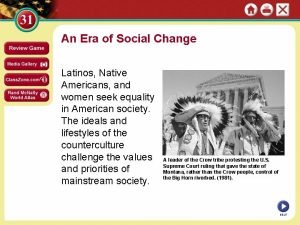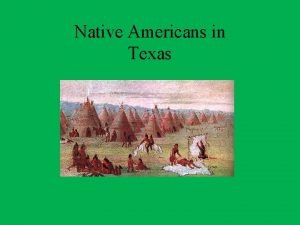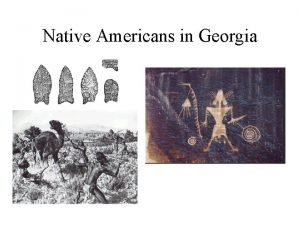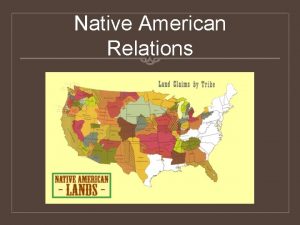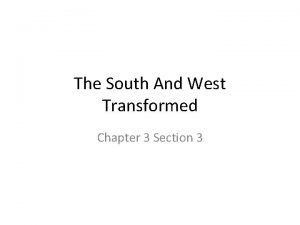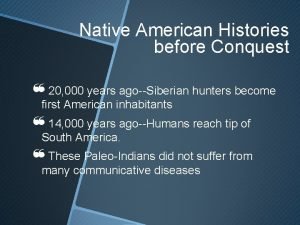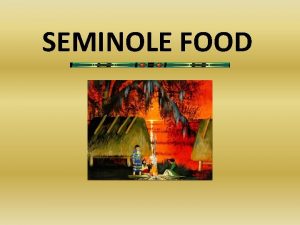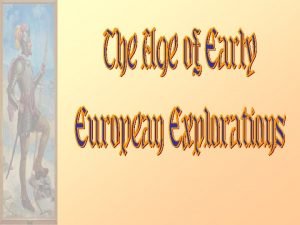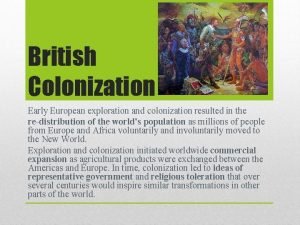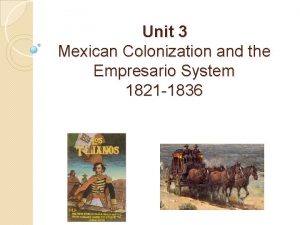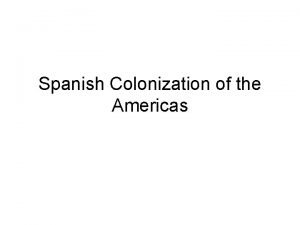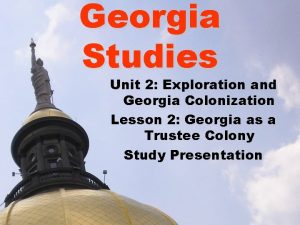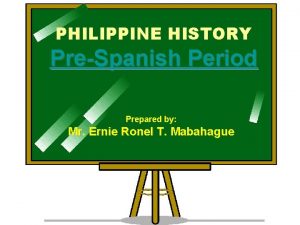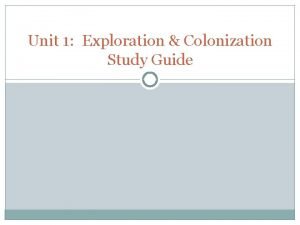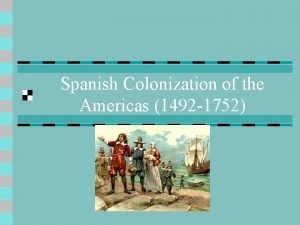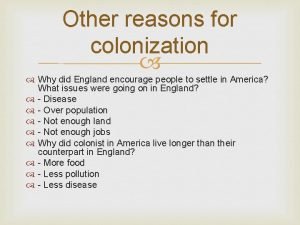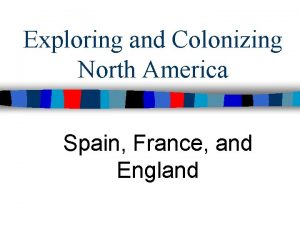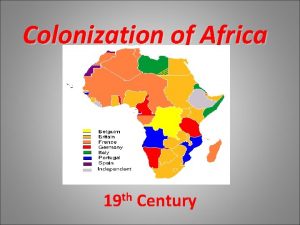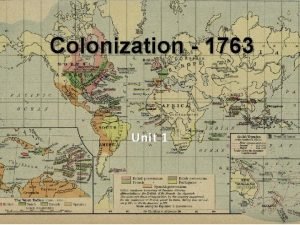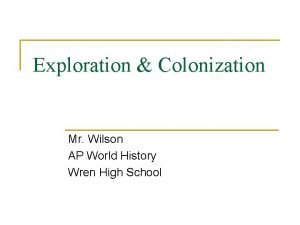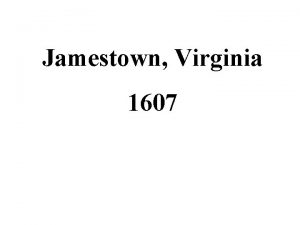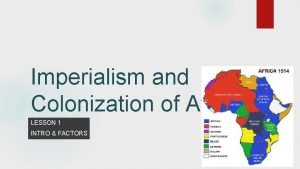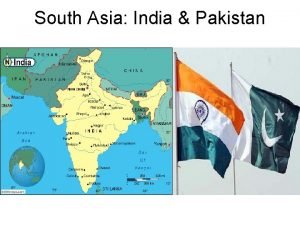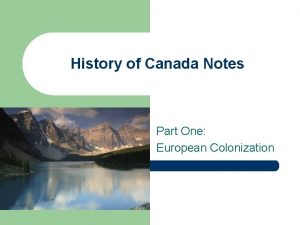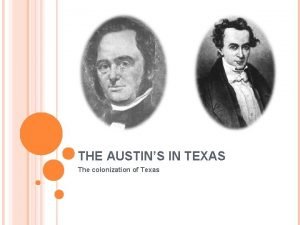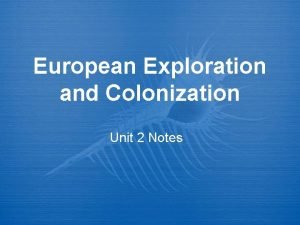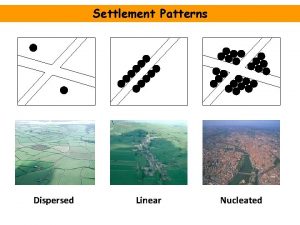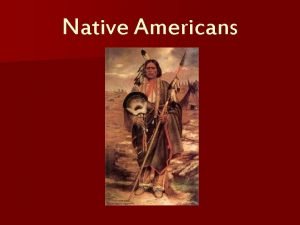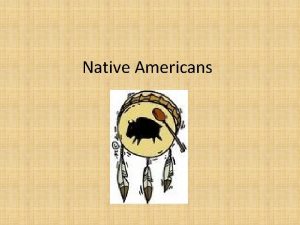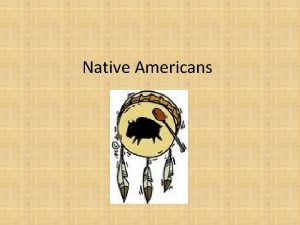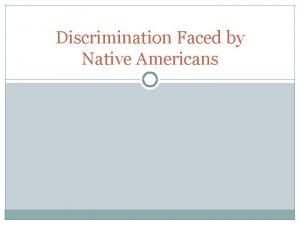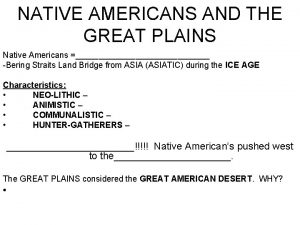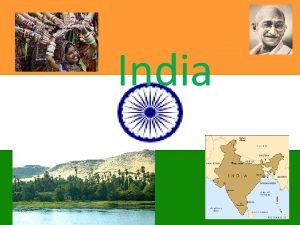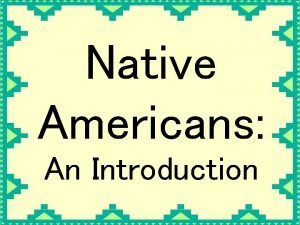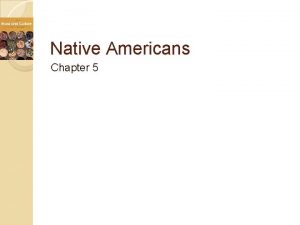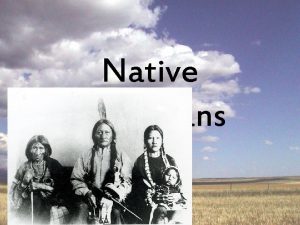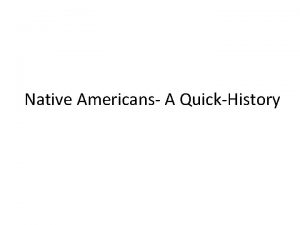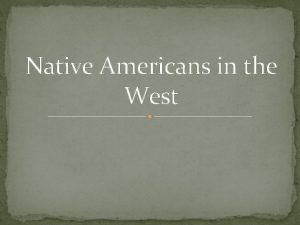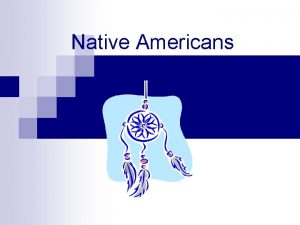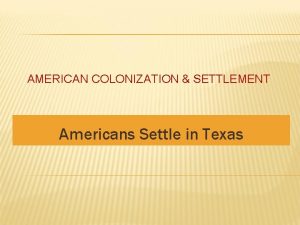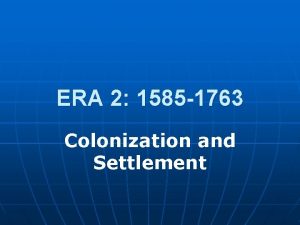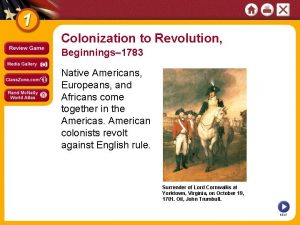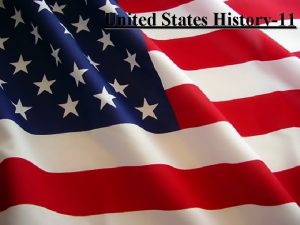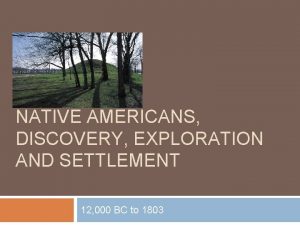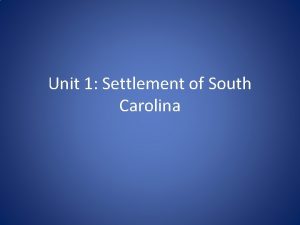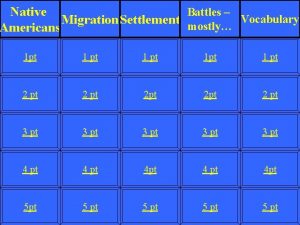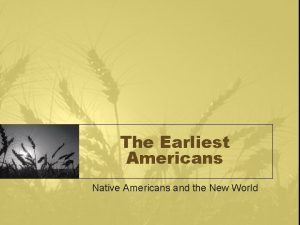Colonization and Settlement Native Americans n n Native





































- Slides: 37

Colonization and Settlement

Native Americans n n Native American tribes lived throughout North America long before Europeans came to explore and settle These tribes had fully developed societies with political, economic, and cultural practices of their own

Native Americans in Tennessee n n Map of Cherokee Country drawn by a British Army officer during the French and Indian War, 1762 Native American villages, including the village of Tanasi, which gave the state its name, are listed

Characteristics of Native American/Colonial relations n n Europeans took advantage of divisions within Native American groups, playing one tribe against another The Spanish set up numerous Catholic missions in the New World. In general Catholics were more successful than Protestants converting Native Americans to their religion Rum and guns had a very damaging effect on natives, who came to depend on manufactured goods rather than things they used to produce for themselves If Native Americans initially believed that Europeans were gods, that concept changed quickly, and the Europeans were incorporated into their political and economic systems. (See below for an example)

Encounters n n Many of the changes that took place in the New World were the result of encounters between Europeans and Native Americans Beginning in the fifteenth century, Europeans were able to cross the ocean more effectively because of better ships, such as the Spanish caravel, the compass, and the astrolabe. The astrolabe helped them find their bearings on the open sea.

Native Americans clash with Europeans n n Warfare frequently took place between Europeans and Native Americans These two completely alien cultures often clashed; the Native Americans were usually (but not always) on the losing side

Native American customs n n Europeans were fascinated by Native American customs, and hired artists to create and distribute drawings documenting their lifestyle These prints are not always a reliable source for learning about their traditions

Native American cultural differences n n The diets of Native Americans were sometimes different from what Westerners were accustomed to at home Smoking meat was a common way for Native Americans to prepare game and prevent its spoilage

De Soto & the Conquistadors n n n The Spanish conquistadors were the first to invade the Continental U. S, beginning in the early 16 th century. Hernando De Soto came to America from 1539 -1542 seeking gold & riches He left a wake of destruction and brought European diseases that devastated Native American tribes

Early Settlements and Expansion n n De Soto was the first European to claim (for Spain) the region around the Mississippi River; the area was a part of the 1803 Louisiana Purchase Louisiana extended from the Mississippi River to the Rocky Mountains; this map is one of the first to show the Mississippi River in an accurate fashion

European Settlements n n New Spain (Mexico, Central America, Southwestern United States) New France (Quebec, Montreal, Nova Scotia) New England (Massachusetts) New Netherlands (New York)

The Colonies in America • Each region was a unique blend of European traditions, • • the local environment, Native American culture, and African culture In part, new colonies were established because European countries were trying to build their empires Colonization encouraged the rapid exchange of plants, animals, and diseases Relations between Native Americans and Europeans frequently began with peace but often disintegrated into violence. Many colonists sought religious freedom and new land

Virginia • Virginia was home of some of • the first settlements in America, including Jamestown and Williamsburg After hopes that Virginia could provide England with gold were dashed, it was discovered that tobacco could serve as a valuable cash crop; the image on the right was produced by European merchants advertising the new commodity by showing exotic natives with a hogshead of tobacco.

1590 Map of Virginia, showing the region around the Roanoke Colony

Jamestown • Founded in 1607 by the • • Virginia Company of London Captain John Smith asserted himself as leader Most of the settlers were “gentlemen” without skills who simply sought gold and riches; most eventually died of disease and starvation Upon his departure in 1609 the colony fell into disarray An influx of new residents, the discovery of tobacco as an ideal crop for the region, and cessation of warfare against the Native Americans helped save Jamestown.

Jamestown • Pocahontas (or Matoaka) was • • captured in 1613 by Virginians She is famous for her intervention to save Captain John Smith’s life after local Native Americans captured him and appeared to prepare to execute him. She converted to Christianity, acquired the name Rebecca (her baptized name), and married John Rolfe in 1614. She later died in England of smallpox at age 22.

Virginia Map • Captain John Smith’s map of • • Virginia, published in 1612 He provides the first reasonably accurate rendering of the Chesapeake Bay He includes the location of nearly two hundred Indian settlements Powhatan is pictured on the top left, and the large figure on the right is a Susquehanna chief Importance of such accounts and maps as publicity for prospective settlers in Europe

Jamestown Massacre of 1622 • Early print of • Powhaten confederacy’s attempt to wipe out the English on March 22, 1622. The Native Americans were ultimately subdued, but only after much bloodshed

Virginia Money • The punishment for • conterfeiting colonial money was death, although the problem still occurred Colonies began to shift from barter economy to a more complex system that used money

Virginia Passport/Letter of Introduction • Passport/Letter of • introduction dates from October 18, 1765 Document granted Robert Cartwright permission to travel to North Carolina, and vouched for his good character

New England • Includes New Hampshire, • • • Massachusetts, Rhode Island, Connecticut The Mayflower Compact was established in 1620 by the Pilgrim leaders; about 102 people, or twenty-four families, were on the ship. All men were required to sign and establish themselves as the official civic government of the Plymouth plantation under King James I. The Puritans dominated Massachusetts and sought to build a godly community The Puritans rejected the Church of England (the Anglican Church) in favor of their stricter religious beliefs

Plymouth Land Record (1730) • This is a land deed from • • Plymouth, Massachusetts, signed on October 8, 1730 Although the record dates much later than the 1620 founding of Plymouth by the Pilgrims, it pertains to the same area Separatist Puritans, known as Pilgrims, left England in search of religious freedom

Chesapeake Colonies • The region included the • • modern-day states of Maryland Virginia Tobacco was the primary crop of the region; prices plunged in the 1620 s but remained profitable until about 1660 This image on the right pictures the slave’s role in growing tobacco and his obligation to serve his white master

The Carolinas • The Colony of Carolina was established by West • • • Indian planters in the 1670 s (notably, Charles Town); only in 1729 were two royal colonies created, North and South Carolina. For fear that they might collaborate, the leaders pitted Indians and slaves against each other. Settlers were offered religious toleration, political representation, and large grants of land Slaves were used to cultivate rice beginning in the early eighteenth century

One Carolinian: his mathbook • Math book used in 1742 • • by John Walker, a 16 year old North Carolinian The math problem asks how many days, hours, and minutes have passed since Christ’s birth Religion was integrated into all facets of everyday life, including learning

Map for Immigrants • Map was published in • Germany to promote emigration to Virginia Illustration in lower right corner promoted the idea of endless New World bounty and wealth

Middle Colonies • Includes modern-day New York, Pennsylvania, New • • • Jersey The Dutch established New Amsterdam (New York), which was conquered and formally turned over the British in 1667 Pennsylvania attracted William Penn and the Society of Friends, known as Quakers, as well as others. The importance placed on religious tolerance attracted these settlers. Quakers were non-violent, anti-slavery, and believed that the Holy Spirit (or “Inner Light”) inspired each soul, without the assistance of a preacher or formal service

West Indies • A small but rich planter elite • • was sustained by a slave economy Rice and sugar were the primary crops in the West Indies, in addition to tobacco The image on the right pictures slaves feeding sugar cane into rollers (L), which crushed out the juice that flowed in a tank (E) for ladling into coppers (K). The juice was then boiled. The process was extremely laborintensive and technically complicated.

Slavery in the New World Slaves endured terrible conditions on slave ships during the so-called Middle Passage from Africa. n Some of the worst conditions for slaves were in the West Indies, although slaves perished from disease, abuse, and neglect throughout the colonies. n

The journey from Africa n In the early 17 th century, as many as 20% of slaves perished on their journey across the Atlantic; this image shows captured Africans in the hold of a slave ship

The Atlantic Trade “Triangle”

The Slave Economy Slaves worked on tobacco fields in Maryland, Delaware, Virginia, and parts of North Carolina, and rice and indigo in Georgia, South Carolina, and parts of North Carolina n Slaves in the West Indies farmed sugar n

Slave Bill of Sale This bill of sale records the sale of a slave, Pomp (short for Pompey) from a tailor to a shipwright n The document was signed in 1763 n

Slaves as chattel Slaves were treated as a form of property, kept in place by a system of legal coercion n This notice for a runaway slave was published in the n Knoxville Gazette

Indentured Servitude Many of those working in Virginia and Maryland under conditions similar to slavery were white indentured servants from Europe n The only way they could secure their passage to the New World was through indentured servitude or temporary bondage n Many were required to work for a period of five or more years before they were granted their freedom n

Looking ahead n n King George III’s royal proclamation of 1763 forbade colonial settlers from moving West of the Appalachian Mountains This order was widely ignored. Colonists were constantly seeking new land to the West despite threat of Native American resistance

Tennessee and the expansion west n n n Settlers went west, seeking land, as much of the land in the thirteen colonies were unavailable to them Many went by way of the Wilderness Road, which cut though the Cumberland Gap Natural resources in the area, such as abundant game and cheap land, were an attraction for settlers
 Latinos and native americans seek equality
Latinos and native americans seek equality Coahuiltecan tattoos
Coahuiltecan tattoos Where did native americans come from
Where did native americans come from How many native americans died on the trail of tears
How many native americans died on the trail of tears What three circumstances hurt native americans
What three circumstances hurt native americans Portuguese sailor
Portuguese sailor What did native americans eat
What did native americans eat What is the cycle of conquest
What is the cycle of conquest Early european exploration and colonization resulted in -
Early european exploration and colonization resulted in - Spanish empresario system
Spanish empresario system Gold, glory, and god
Gold, glory, and god Unit 2 exploration and georgia colonization
Unit 2 exploration and georgia colonization Social classes in the philippines spanish era
Social classes in the philippines spanish era Unit 1 exploration and colonization
Unit 1 exploration and colonization Spanish colonization of the americas
Spanish colonization of the americas Reason for colonization
Reason for colonization Columbian exchange
Columbian exchange When did britain colonize america
When did britain colonize america Colonization of africa
Colonization of africa Colonization
Colonization After 1880 european colonization was motivated by the
After 1880 european colonization was motivated by the Castas indianas
Castas indianas Colonization acrostic poem
Colonization acrostic poem Indigenous defenition
Indigenous defenition Bacteria defenition
Bacteria defenition Space colonization
Space colonization Jamestown reason for colonization
Jamestown reason for colonization Reasons for colonization in america
Reasons for colonization in america Colonization
Colonization French colonization apush
French colonization apush Asia colonization map
Asia colonization map Is canada british territory
Is canada british territory Moses austin cartoon
Moses austin cartoon 3 g's spanish colonization
3 g's spanish colonization British and american word differences
British and american word differences Vocabulary differences in british and american english
Vocabulary differences in british and american english Advantages and disadvantages of clustered settlement
Advantages and disadvantages of clustered settlement Linear settlement pattern
Linear settlement pattern
